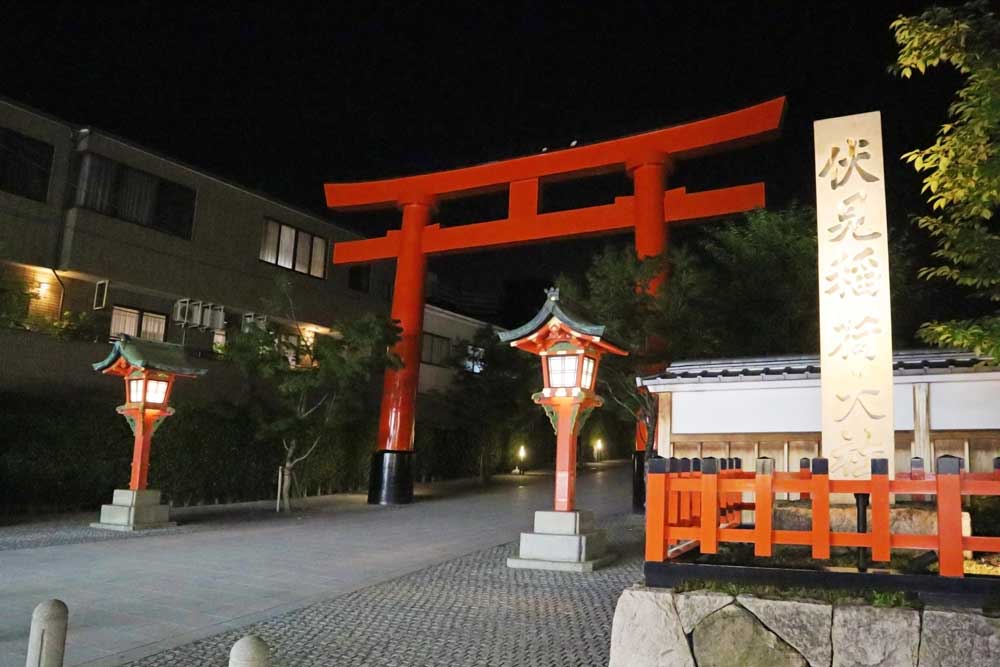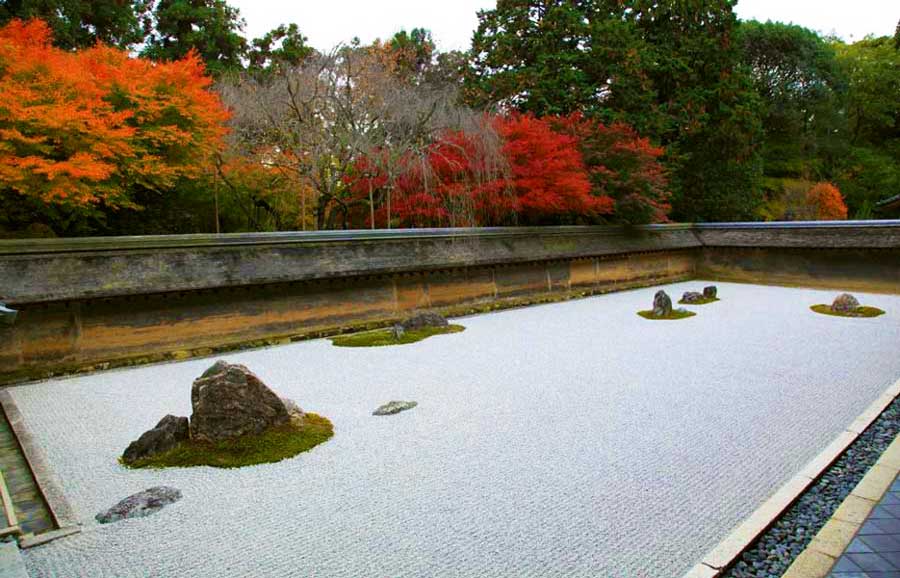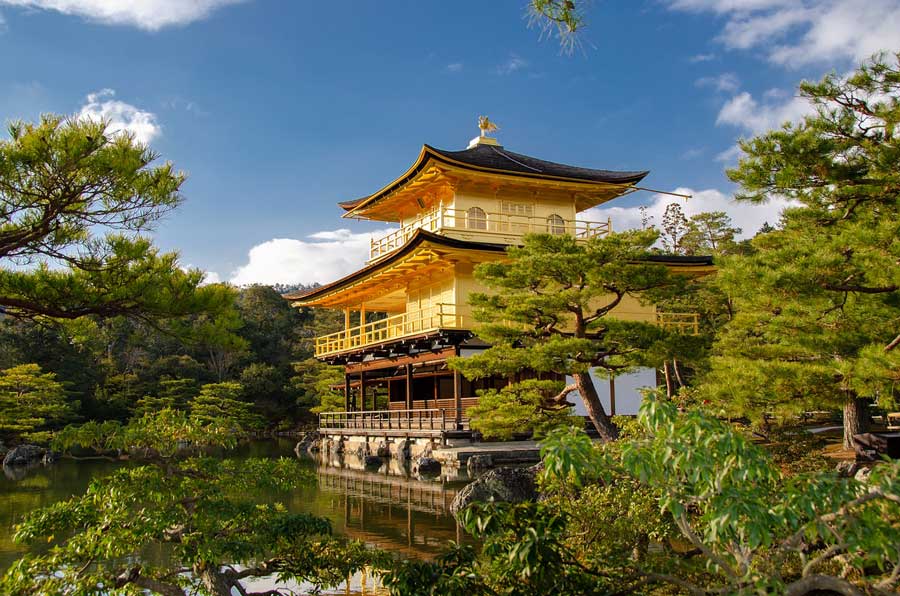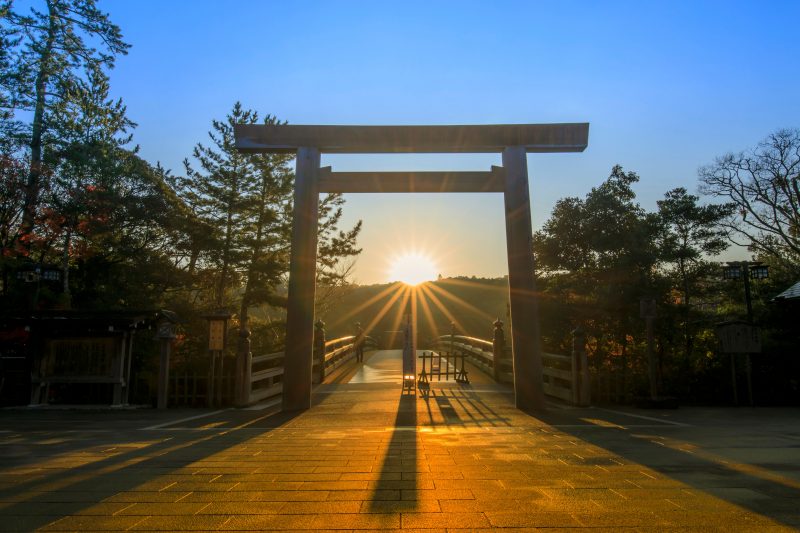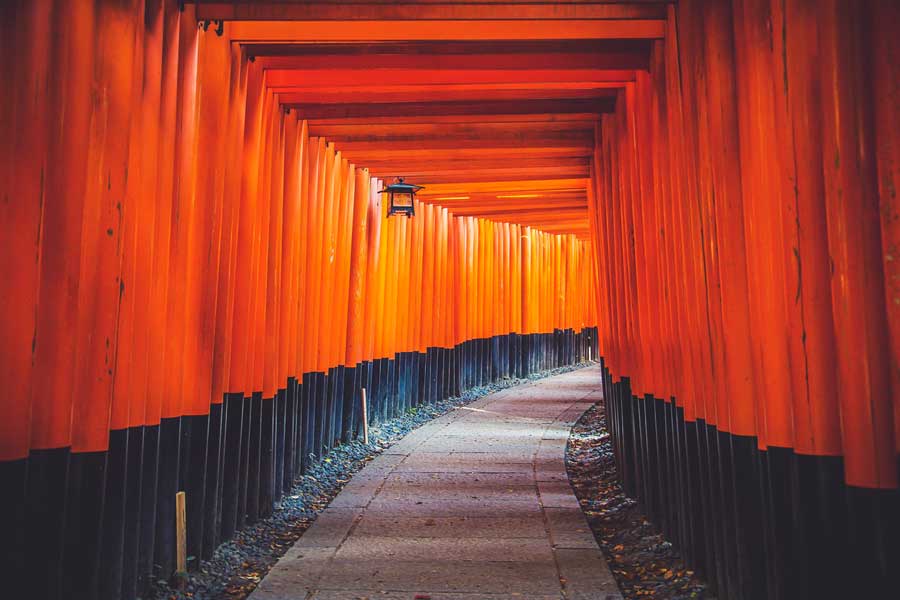
鮮やかな朱色の「千本鳥居」で世界的にも大変有名な「伏見稲荷大社」。
鳥居だけでなく、その神秘的な雰囲気に包まれた境内や稲成山頂からの美しい眺めなど、京都でも屈指の観光スポットとして不動の人気を誇っています。
今回は、そんな伏見稲荷大社を英語で簡単に説明する表現をご紹介していきます。
ご興味のある方は、当サイトで 英語クイズ(5000問) を出題しておりますので是非ご覧ください。
目次
伏見稲荷大社へのアクセス
Fushimi Inari Shrine is located in the southern part of Kyoto, which is a world-famous tourist city with many historical buildings.
(伏見稲荷大社は、多くの歴史的建造物で世界的に有名な観光都市である京都の南部に位置しています。)
Fushimi Inari Taisha is most easily accessed by train, about a five-minute ride from Kyoto Station.
(伏見稲荷大社へ最も簡単にアクセスできるのは電車で、京都駅から5分ほどです。)
Take either the JR Nara line and get off at Inari station (2 stops from Kyoto station), or take the Keihan line and alight at Fushimi Inari Station.
(JR奈良線で2駅目の稲荷駅で下車するか、または京阪本線の伏見稲荷駅で下車します。)
Please note that only local trains stop at Inari Station.
(稲荷駅には各駅停車しか停まりませんので注意してください。)
Both stations are very close to Fushimi Inari Taisha, and it’s about a three-minute walk to the shrine.
(いずれの駅も伏見稲荷大社からとても近く、歩いて3分ほどです。)
If you go by bus, take the Kyoto city bus South 5 and get off at “Inaritaisha-mae.” However, I don’t recommend it because buses are only operated twice per hour.
(バスで行くのであれば、京都市バスの南5系統に乗って「稲荷大社前」で下車します。しかしながら、バスは一時間に2本しかないため、お勧めはしません。)
・alternatively:(別の提案を出して) または、もしくは、その代わりに
・alight:❶(鳥・昆虫などが) 降りて止まる ❷(乗り物などから) 降りる
伏見稲荷大社の魅力
Founded in 711 AD, the Fushimi Inari Shrine has more than 1,300 years of history and is one of Kyoto’s most popular spots among tourists from overseas.
(711年に創建された伏見稲荷大社は1300年以上の歴史があり、外国人に最も人気の高い京都の観光スポットのひとつです。)
The shrine is located in Fushimi Ward, Kyoto City and is world-famous for its thousand Torii gates.
(京都の伏見区にあり、数千もの鳥居があることで世界的に有名です。)
Fushimi Inari Taisha is the head of all 30,000 Inari shrines nationwide that worship the Shinto deity Inari Daimyojin, popularly known as “Oinari-san.”
(伏見稲荷大社は、「お稲荷さん」として親しまれている稲荷大明神を祀る全国の3万の稲荷神社の総本宮です。)
As you explore the shrine, you will find many fox stone statues. The fox is considered the messenger of “Inari,” the god of rice.
(神社を探索すると、たくさんの狐の石像が見つかります。狐は稲荷神の使者とされています。)
Ro-mon gate, the main entrance to Fushimi Inari, was donated in 1589 by Toyotomi Hideyoshi in gratitude that prayers for his mother’s recovery from illness were answered.
(楼門は、1589年に豊臣秀吉によって母親の快癒を祈願して奉納されたものです。)
The shrine is always open and can be visited at any time of the day, even at night.
(神社は常に開いていますので、いつでも、夜でさえも訪れることができます。)
千本鳥居
“Senbon torii” means 1,000 torii gates. The number 1,000 is actually just a metaphor for “many.”
(1,000 という数字は、それだけ「数が多い」ことを象徴的に表しています。)
There are about thousands of torii in the precincts of the Fushimi Inari shrine, including the main torii and other torii.
(伏見稲荷大社の境内には、大鳥居やその他の鳥居を含め、数千もの鳥居があります。)
The vermilion red color of the torii gates symbolizes good harvests.
(朱色は五穀豊穣を表しています。)
People dedicate torii to the shrine as a sign of gratitude when their wishes are fulfilled. The name of the donor and the date of dedication are written on each of the pillars.
(鳥居は、願いが叶えられた時の御礼のしるしとして神社に奉納します。鳥居の柱には奉納者と名前と奉納日が書かれています。)
During the Edo period, the Inari faith became popular for bringing blessings to the merchant class and ordinary people, and there was a custom of dedicating a vermilion torii in gratitude for answered prayers.
(江戸時代、稲荷信仰は商人や庶民に幸運をもたらすとして人気を博し、願いが叶った御礼に朱色の鳥居を奉納する習慣がありました。)
When you visit the shrine, make sure to experience the mysterious atmosphere of the vermilion tunnel leading to the top of the Inari mountain.
(伏見稲荷大社を訪れたら、稲荷山の頂へと続く朱色のトンネルの不思議な雰囲気を是非体験してみてください。)
秦氏
The name “Hata” is most often mentioned as an immigrant clan in Japanese mythology and history.
(秦の名は日本の神話や歴史において、渡来系氏族の中で最も多く言及されています。)
Fushimi Inari shrine was originally dedicated to the gods of rice Inari by the Hata family, an immigrant family active in Japan since the Kofun period, roughly from the 3rd century to the 6th century, according to the Chronicles of Japan, “Nihon Shoki.”
(「日本書紀」によると、伏見稲荷大社は3世紀から6世紀頃の古墳時代に日本で活躍した「秦」という渡来系一族によって、穀物神である稲荷神を奉鎮したのが始まりだと書かれています。)
One day, one of the Hata family members, Irogu no Hatanokimi, was practicing archery using mochi (rice cakes) as targets. Legend has it that an arrow pierced a mochi which then magically transformed into a swan, and a rice plant began to grow where it alighted on the peak of the mountain (modern-day Mt. Inari).
(ある日、秦一族の伊侶具の秦公がお餅を的にして矢を射ったところ、お餅が白鳥の姿に変わって、山の頂上に降り立ったその場所から稲が育ったのだそうです。)
That year they had a very poor rice harvest because of bad weather and prayed to God for help. God told the people to build a shrine for the God of Agriculture. They did so, and they were blessed with a rich harvest.
(その年は悪天候のため不作だったので祈祷したところ、大神を祀るようにとのお告げがあり、彼らがその通りにすると大いに穂が稔り栄えたというのです。)
This miraculous event marks the beginning of the Inari faith and gives the Mountain Inari its name.
(この奇跡的な出来事が稲荷信仰の始まりであり、その山に稲荷山の名を付けたのです。)
It is said that the economic power of the Hata clan was so important in the transfer of the national capital to Kyoto, and they have aided in the establishment of the ancient capital Heian-kyō, and of many Shinto shrines and Buddhist temples, including Yasaka Shrine, Matsunoo-Taisha, and Kōryū-ji.
(秦氏の経済力は、首都を平安京に移す上で非常に重要であり、秦氏は八坂神社、松尾大社、広隆寺など、多くの神社や仏教寺院の設立に貢献したと言われています。)
The notion that the Hata clan were one of “the Lost Tribes” of Israel, though far from seriously discussed in public, is famous among urban legend lovers.
(秦氏がイスラエルの「失われた10氏族」の中にいたという考えは、公で真剣に議論されたりすることはないものの、都市伝説好きな人たちの間で有名です。)
・dedicate . . . to:(時間・人生・労力などを、研究・活動などに) ささげる、専念する、打ち込む
・alight:(鳥・昆虫などが) 降りて止まる
